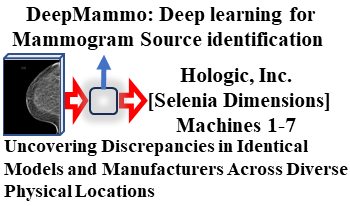
Advances in AI allow for fake image creation. These techniques can be used to fake mammograms. This could impact patient care and medicolegal cases. One method to verify that an image is original is to confirm the source of the image. A deep-learning algorithm(DeepMammo)-based on CNNs and FCNNs, used to identify the machine that created any mammogram. We analyze mammograms of 1574 patients obtained on 7-different mammography machines and randomly split the dataset by patient into training/validation(80%) and test(20%) datasets. DeepMammo has an accuracy of 98.09%, AUC of 95.96% in the test dataset.

We present a head-mounted holographic display system for thermographic image overlay, biometric sensing, and wireless telemetry. The system is lightweight and reconfigurable for multiple field applications, including object contour detection and enhancement, breathing rate detection, and telemetry over a mobile phone for peer-to-peer communication and incident commanding dashboard. Due to the constraints of the limited computing power of an embedded system, we developed a lightweight image processing algorithm for edge detection and breath rate detection, as well as an image compression codec. The system can be integrated into a helmet or personal protection equipment such as a face shield or goggles. It can be applied to firefighting, medical emergency response, and other first-response operations. Finally, we present a case study of "Cold Trailing" for forest fire prevention in the wild.

Multiple Sclerosis (MS) is a chronic, often disabling, autoimmune disease affecting the central nervous system and characterized by demyelination and neuropathic alterations. Magnetic Resonance (MR) images plays a pivotal role in the diagnosis and the screening of MS. MR images identify and localize demyelinating lesions (or plaques) and possible associated atrophic lesions whose MR aspect is in relation with the evolution of the disease. We propose a novel MS lesions segmentation method for MR images, based on Convolutional Neural Networks (CNNs) and partial self-supervision and studied the pros and cons of using self-supervision for the current segmentation task. Investigating the transferability by freezing the firsts convolutional layers, we discovered that improvements are obtained when the CNN is retrained from the first layers. We believe such results suggest that MRI segmentation is a singular task needing high level analysis from the very first stages of the vision process, as opposed to vision tasks aimed at day-to-day life such as face recognition or traffic sign classification. The evaluation of segmentation quality has been performed on full image size binary maps assembled from predictions on image patches from an unseen database.
